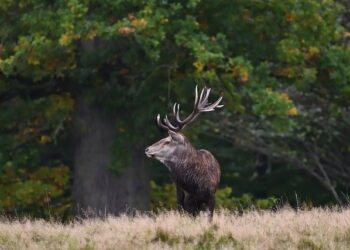In a world where tropical forests are rapidly being transformed by human activities, new research sheds light on the intricate dynamics of plant survival and adaptation in altered ecosystems. A recent study published in Nature examines the phenomenon of “winner-loser plant trait replacements” in these human-modified landscapes, revealing how certain species thrive while others decline. As deforestation, agricultural expansion, and urbanization reshape the tropics, understanding the traits that enable some plants to dominate while others falter is crucial not only for biodiversity conservation but also for the health of our planet. This research could provide valuable insights into the resilience of tropical forests, offering a glimmer of hope amidst the ongoing environmental crisis. As scientists delve into the complexities of plant interactions in altered habitats, the findings underscore the urgent need to rethink our approaches to forest management and conservation in a rapidly changing world.
Examining Plant Trait Shifts in Human-Modified Tropical Forests
Recent studies have illuminated the dynamics of plant trait replacements in tropical forests altered by human activities. With increasing deforestation and land conversion, native species are often outcompeted by non-native invaders, leading to significant shifts in the ecosystem’s functional traits. Key characteristics, such as growth rate, seed size, and drought resistance, are pivotal in determining which species thrive in modified environments. The following traits have been observed to dominate in winner species:
- Fast growth rate – Essential for rapid establishment in disturbed areas.
- Smaller seeds – Allow for easier dispersal and colonization of new habitats.
- Drought tolerance – Increasingly important in the face of climate variability.
Conversely, a decline in loser species showcases a concerning trend. Many endemic plants with specialized traits, which once thrived in stable conditions, face significant challenges. The contrasting survival strategies highlight a broader shift within these ecosystems, influenced profoundly by anthropogenic pressures. A summary comparison of winner versus loser traits in these forests is illustrated below:
| Trait Category | Winner Species Traits | Loser Species Traits |
|---|---|---|
| Growth Strategy | Fast | Slow |
| Seed Size | Small | Large |
| Drought Adaptation | High | Low |
Understanding the Ecological Impact of Winner-Loser Dynamics
The dynamics of winner-loser interactions among plant species in human-altered tropical forests have far-reaching implications for ecological balance and biodiversity. In these environments, the introduction of non-native species, along with anthropogenic disturbances like logging and agriculture, has created competitive scenarios where some plants thrive while others struggle to survive. This phenomenon often leads to a cascading effect on local ecosystems, influencing everything from soil health to wildlife habitats. The winner species, typically more resilient or adaptable to changing conditions, exert pressure on loser species, which may face diminished growth and reproductive success due to competition for resources such as light, nutrients, and water.
Understanding the ecological ramifications of these shifts can help inform conservation strategies and forest management practices. Key factors to consider include:
- Species Composition: Monitoring changes in plant diversity can reveal the resilience of ecosystems.
- Nutrient Cycling: Winner species often alter soil chemistry, impacting nutrient availability for all species.
- Habitat Structure: Altered plant communities can change the physical structure of habitats, affecting fauna.
- Invasive Species Management: Identifying winners among invasive species can guide effective control measures.
In a recent study examining this phenomenon, researchers noted that forests dominated by resilient species could lead to simplified ecosystems that lack the complexity needed to support rich biodiversity. This calls for further investigation into the mechanisms driving these winner-loser dynamics and the development of strategic interventions aimed at restoring ecological balance.
Strategies for Enhancing Biodiversity in Altered Ecosystems
In the complex landscape of human-modified tropical forests, several strategies can be employed to bolster biodiversity and foster resilient ecosystems. One effective approach is the reintroduction of native plant species that support a variety of wildlife, thereby enhancing both plant and animal diversity. Integrating these native species involves understanding their specific ecological roles and interactions, which can be achieved through:
- Selective Planting: Prioritize planting native species that provide critical habitat and resources for local fauna.
- Habitat Restoration: Restore degraded areas by removing invasive species and allowing native flora to thrive.
- Community Engagement: Involve local communities in conservation efforts, ensuring sustainable management practices are employed.
Another promising method involves the identification and promotion of plant traits that enhance ecosystem services and improve the chances of survival for target species. Research suggests that understanding traits linked to drought tolerance, nutrient cycling, and pest resistance can lead to more targeted conservation strategies. Implementing this understanding may include:
| Plant Trait | Benefits |
|---|---|
| Drought Tolerance | Supports survival during dry spells, ensuring ecosystem stability. |
| Fast Growth Rates | Accelerates forest recovery and soil stabilization. |
| Pest Resistance | Reduces the need for pesticides, promoting a healthier ecosystem. |
Closing Remarks
the dynamic interplay between winner and loser plant traits in human-modified tropical forests offers critical insights into the resilience and adaptability of these vital ecosystems. As researchers continue to unveil the complex relationships governing plant survival and dominance in altered environments, it becomes increasingly evident that understanding these shifts is essential for effective conservation strategies. The findings highlight the urgent need for sustainable land management practices that account for the ecological intricacies of these transformed landscapes. As human activity continues to reshape our planet, paying attention to the evolutionary responses of tropical flora not only enhances our knowledge of biodiversity but also underscores the imperative for a harmonious coexistence with nature. The ongoing discourse around these ecological changes calls on both scientists and policymakers to prioritize the preservation of our planet’s remarkable biodiversity, ensuring that future generations can experience the rich tapestry of life that tropical forests provide.


























![Forest ecology cannot be reduced to arithmetic, says M.I. Varghese [Interview] – Mongabay-India](https://earth-news.info/wp-content/uploads/2025/12/328946-forest-ecology-cannot-be-reduced-to-arithmetic-says-mi-varghese-interview-mongabay-india-120x86.jpg)




